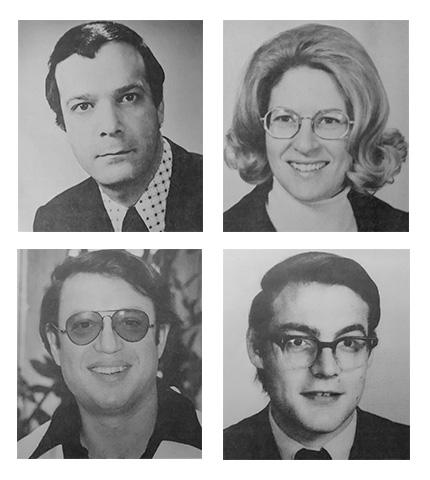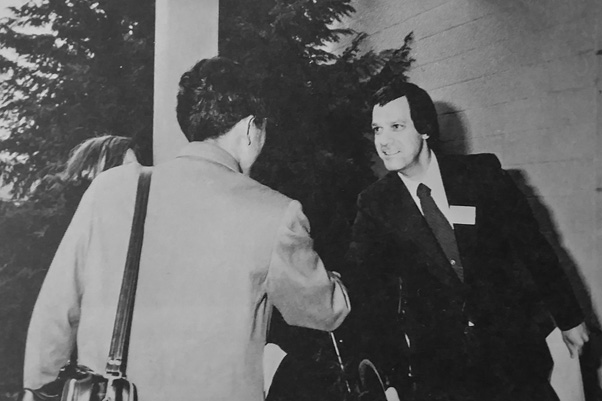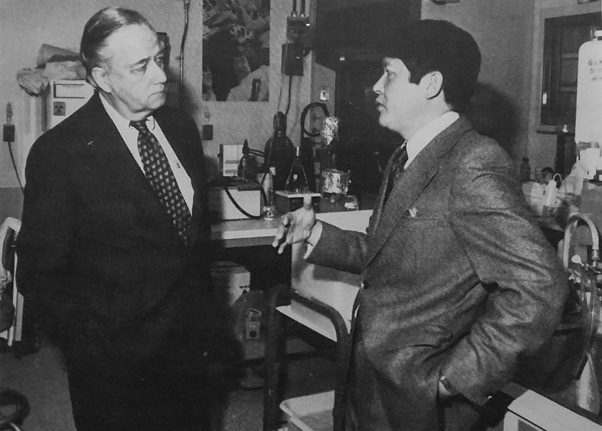Editor’s note: This is the third installment of a series about the history of the National Cancer Institute at Frederick and the Frederick National Laboratory for Cancer Research, and the second installment in a three-part miniseries about the original Basic Research Program.
By early 1974, the concept of the first investigator-initiated research program in Frederick was firmly approved. The idea had passed through the necessary channels, and the National Cancer Institute (NCI) and the Frederick Cancer Research Center (FCRC) set about making it a reality.
‘Dark Horse’ Becomes Director
FCRC published a press release advertising the position of program director on January 29, 1974. At the same time, NCI Director Frank Rauscher Jr., Ph.D., invited cancer researchers to submit their suggestions for candidates to Robert Stevenson, Ph.D., FCRC general manager and search committee chair.
Michael G. Hanna Jr., Ph.D., was a thirtysomething-year-old scientist and director of the Immunology of Carcinogenesis Group at Oak Ridge National Laboratory in Tennessee when he got a call about the job. He had heard of FCRC in passing and was only mildly aware of the search, but a colleague must have recommended him to the committee.
“They wanted to interview me,” he recalled. “Actually, they wanted to interview five people from Oak Ridge, and they asked all five of us to come up at the same time to be interviewed at the FCRC.”
The group boarded a plane and flew to Frederick, yet Hanna was sidelined soon after arriving. He developed severe gastritis from eating a bad oyster and had to be hospitalized. Frederick Memorial Hospital discharged him the following morning, but instead of traveling the few short blocks west to FCRC for his tour and interview, he headed southeast toward the airport, where he bought a ticket and flew back to Tennessee.
“I was sick, and I just wanted to get home,” he said.
Hanna felt that the mishap had cost him his shot at the position, but he made peace with it. He hadn’t been certain about the opportunity, anyway.
In July 1974, he got a surprise.
“I got another call from them, and they said, ‘We’re going to be … interviewing some people in New York, and we want to interview you. Would you come to New York?’” he said.
Serendipitously, he was preparing to travel to the United Kingdom for the Second International Congress on Immunology. The flight included a stopover at John F. Kennedy International Airport in Queens. Hanna remained ambivalent but decided to give the opportunity a chance, and the committee members agreed to meet him at his hotel and interview him before his flight overseas.
“I was very relaxed [in the interview] because I didn’t want [the position], I knew they weren’t going to want me, and I had to catch a plane,” he recalled, citing how he was a young scientist and an underdog candidate.
He received his second surprise after arriving at the airport and boarding the plane for the United Kingdom. An attendant presented him with a small bottle of champagne, compliments of the search committee, and said they wanted to offer him the job once he returned.
The offer occupied Hanna’s thoughts throughout the conference. He realized the magnitude of the scientific opportunity and the benefits that moving to Frederick, a less insulated community than Oak Ridge, would bring his family.
When he returned to the U.S. a few days later, he met with NCI Director Rauscher in Bethesda to discuss the position. Then he drove to FCRC for a tour and meetings with its staff.
He accepted the offer.
The Minds Gather
Hanna won out over a field of 80 candidates, but his selection veered from the Weinhouse Committee’s recommendation to recruit a widely renowned scientist. Few nationally acclaimed researchers were referred to the search committee. Hanna himself recognized that he wasn’t one of them, as did Rauscher, the committee, and others.
Instead, the committee reported seeing in him “a younger scientist of demonstrated ability and likelihood of future growth, with a clear concept of purpose and an imaginative program.” His recruitment apparently was a chance to bring a fresh scientific perspective to the young FCRC, and his proposed interdisciplinary program—cancer immunobiology—seemed promising.
“[He is] a bright young man who can attract the kind of people we need to develop a first rate [sic] program at Frederick,” Rauscher said at the time.
The claim proved to be true. By the time news of the selection broke, three other promising young scientists had already accepted Hanna’s invitations to lead new sections in the Basic Research Program.
All three were warm colleagues with Hanna and shared the hope of doing meaningful research at Frederick. Margaret Kripke, Ph.D., came from an assistant professorship at University of Utah. Isaiah “Josh” Fidler, D.V.M., Ph.D., left a tenured associate professorship at University of Pennsylvania to join the program. James Ihle, Ph.D., like Hanna, moved to Frederick from Oak Ridge National Laboratory.
“For me, it was an opportunity, a real growth opportunity, because it was leadership experience. It was starting a new laboratory from scratch. It was being part of an exciting, growing program, and there was a lot of enthusiasm and a lot of energy around the science,” Kripke recalled.
Kripke and Fidler had reason to be doubly excited. They wanted to marry and had been looking for an institution to which they could move together. When Hanna contacted them separately to offer leadership roles in the new program, everything clicked.
“[Accepting] seemed like the right thing to do,” said Kripke, who married Fidler in Frederick.
Hanna consulted part-time with Litton Bionetics, FCRC’s contractor, while FCRC prepared for the program during the final months of 1974. Construction crews began renovating Building 539 to accommodate the new laboratories.
Then, early in 1975, the eagerly awaited day arrived. The Basic Research Program officially began operating.
To be continued. Look out for the final installment of the miniseries next week.




